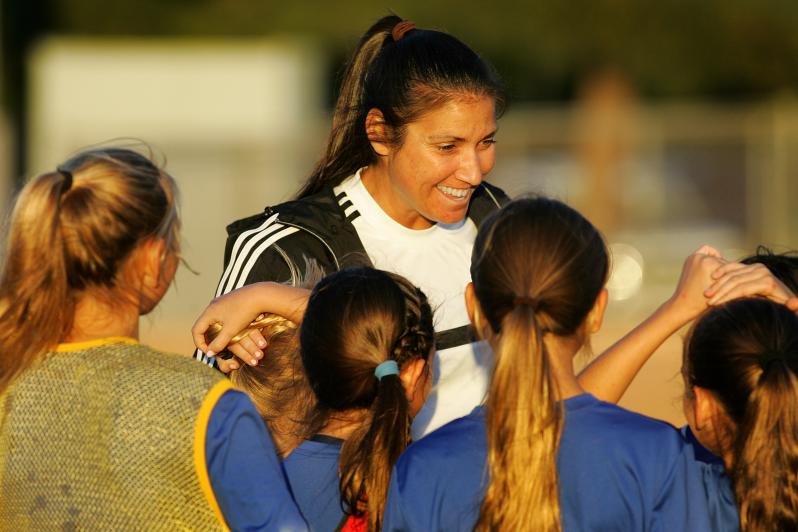When it comes to attracting top talent to your youth club or league, control what you can control and the rest will take care of itself. Sounds easy, right? Well, it’s not always simple to know where to focus to recruit youth players, especially if you want the best.
We sat down with several experienced club directors to find out what they focus on to recruit talented young players (and their families) to their organizations.
The bottom line: it’s vital for directors and administrators to excel in areas they can control such as having a clear philosophy, hiring the right coaches, communicating clearly and remaining affordable enough for many families to participate. Rather than worrying about the whims of individual players or parents, or chasing the latest trends in an increasingly competitive youth soccer landscape, focusing on a simple set of principles allows clubs and leagues to control what they can control — and to recruit talented youth players along the way.
Certainly there are tools that can help make the job easier. As one example, TeamSnap can help managers and administrators more effectively communicate, keep track of schedules and rosters and save as many as 15 hours per week during the season. But running an effective club or league starts with creating the right foundation for the players. Here are six practical tips to help you recruit youth players, drawn from the hard-won experience of top club directors across the country.
Six Tips To Recruit Youth Players To Your Club Or League
Start With A Clear Philosophy
Before a club or league goes anywhere, it must establish a philosophy to encompass what kind of organization it will be. Running a club and recruiting players is completely different if you want to focus on recreational soccer as opposed to being the most competitive club in the state. Some clubs focus on winning, others on player development, others still on creating a passion for the game. Whatever the philosophy, it must be at the core of everything the club does.
“I think it’s important that it is established and that it is understood by the staff members so that the messaging from the director’s desk is very similar in tone and language and execution at the practices occurring on a Thursday afternoon,” said Adam Hayes, director of operations for FC Boulder in Colorado.
Philosophies will vary from club to club and there is no one correct answer. One of the most successful clubs in Arizona, Scottsdale Soccer, focuses on a player-first mentality.
“We focus on the fundamentals; we invest in our players — both as players and as people,” said Chris Brown, executive director of Scottsdale Soccer. “Our Blackhawks tag line is character, commitment, confidence — and this involves a commitment to the player from the coach.”
At FC Boulder Adam Hayes sets out two goals for his organization: individual player development and the idea that soccer is for life.
The philosophies can carry over onto the on-field development as well. At Oregon Futbol Academy, director David Burgee said it’s important to have an established style of play and system of play. Will your club focus on a direct style of play relying on speed and athleticism or build up play from the back and play more technically? Some clubs, Oregon Futbol Academy included, choose one formation and stick with it throughout the age groups.
“Really you want to create experts in particular positions in particular roles,” Burgee said. “By keeping one system throughout, you accomplish that goal.”
All that said, being absolutely rigid is a sure way to limit yourself as a club or league. Being able to continuously improve and adapt is important to ensure you don’t get left behind.
“The clubs directors that are doing the best are the ones that are running organizations that are nimble enough to adapt to what seems like an always changing youth soccer landscape,” Hayes said.
Hire The Right Coaches For The Right Players

Photo: iStock
Once a philosophy is established, the first thing a club or league can do to attract top talent is hiring the right coaches. Coaches are the primary link between a club and the players. They are the most important hire for any soccer organization, large or small, no matter the age or gender of the players. Finding the right coaches and pairing them with the right players is the most impactful thing directors can do to build a club.
“We don’t compromise when we’re hiring coaches,” Hayes said. “We think the coach is the face in front of the players and the club representative to the families more than anyone else is.”
Coaches have a huge influence on athletes, as much as any adult in a young person’s life outside of family, teachers and perhaps church leaders. Finding the right fit for both parties is vital.
“That responsibility is super important and we need to find the best people we can find to work with our players,” Hayes said.
A coach who wants to install high-level tactics and challenge for major titles would be great for older players in a top-tier league but wouldn’t mesh with a group of 8-year-olds learning the game. Likewise, an inexperienced coach who wants to encourage youngsters to get outside and exercise might better encourage a group of 10-year-old rec-league players.
This goes back to having a philosophy in place. Clubs that know who they are and what they want will be able to identify the coaches they need and by extension recruit the right players.
Coaches play a large role in determining how much a player enjoys his or her soccer experience. A good coach in the right position goes a long way toward bringing in the best players.
Develop The Coaches
While hiring coaches is crucial, it means little if the right people get stuck in old ways and are allowed to stagnate. Coaching development is crucial to player development, but it doesn’t get talked about nearly as much.
Coaches who are dedicated to improving themselves will develop players at much higher levels. Burgee at Oregon Futbol Academy focuses intensely in this area and offers free coaching classes every Friday.
“Our club is focusing on coaching education,” said Burgee. “We have plenty of children that want to play soccer. The problem we have is we don’t have enough coaches to train those kids properly. That’s the fundamental problem I think across this country is we don’t have enough quality coaches.”
Good coaches are thieves, Burgee said, constantly looking at what others are doing and improving upon their own methods. Brown, of Scottsdale Soccer, agrees, saying coaching and player development go hand in hand.
“Alongside that is ensuring we are delivering the most appropriate activities and sessions to our players with the correct content delivered to the correct age groups utilizing the most current trends in coaching,” Brown said.
This is essential for clubs who are not located in an area where professional coaches are readily available. Oregon Futbol Academy is in Grants Pass, Oregon, which has a population of around 40,000. Not every coach can be a full-time professional, so volunteers who receive a soccer education must fill in the gaps.
Soccer is an evolving sport with evolving tactics, science and training methods. Even the best coaches must continue to learn or players will go elsewhere.
Place Players With The Right Teammates, Against The Right Opponents

Photo: iStock
Coaches may have the most control over what players do with the club, but who players play with and against has just as much to do with attracting top talent.
First, players want to play with other players on their talent level. A top-level player wants to play with other top-level players while a lower-skilled player will feel out of place if he or she is on a squad with players better than him or her.
On the opposite side of the spectrum, teams should be playing against teams of comparable skill level. Going through a season undefeated may be a great badge of honor, but if that team won every match 6-0, they were never challenged and no one really benefited. Likewise if a team loses every match. Players are much more likely to join a club or organization if they know they’ll be challenged enough to win some, lose some and learn and improve plenty along the way.
“We tell our teams when we place them into league alignment, that a perfect season of 10 games for soccer development is four or five wins, two or three losses and couple ties,” Hayes said. “So you have a chance to experience the different emotions of the game, playing tight matches, learning how to win close matches.
“You want to win more than you lose, that’s fair, but losing a couple is a really good season for player development.”
Ensuring players are placed on appropriate teams and in appropriate leagues will ensure the players and their families want to join your club or organization. Some larger organizations with teams at every level of play may have an advantage in this area with places to put individual players, but every club director can work on providing the best team balance.
Communicate With Players And Parents
Communication is fundamental in all areas of soccer, both on and off the pitch. While coaches work to help players improve communication during a game, communicating away from the field will help retain players and ensure top players don’t overlook your club or organization.
“This is critical and a very important element to the program,” said Brown, of Scottsdale Soccer. “We excel at communication but we want to be proactive with all types of education so that the parent and player are educated and invested in the program.”
Coaches and directors must communicate with players and parents about what kind of league they are getting involved in to avoid problems down the line. Some teams will give everyone equal playing time to ensure everyone has fun. Others will play only the best players to ensure the best chance of winning. Making this clear is important for players and families looking to join a club.
Additionally, players and parents need to know as soon as possible if a practice or match is canceled, postponed or moved to a new location. Weather delays, schedule changes or acts of god happen and coaches and administrators need to have the infrastructure in place to effectively communicate with players and parents. Families will gravitate toward clubs that keep everyone in the loop.
Coaches and administrators have a number of options available for communication, but the days of making dozens of phone calls are long over. One app that can ensure instant contact with members of an organization is TeamSnap, which helps organize all club contacts at the push of a finger.
“Some coaches use it religiously,” Hayes, of Boulder FC, said of TeamSnap.
With wildfires raging all over Oregon recently, air quality degraded to the point games and practices had to be called off. TeamSnap allowed Oregon Futbol Academy to instantly tell players and families about the cancellations and postponements.
“TeamSnap was just a total life saver in order to get that information out immediately,” Burgee said.
Offer Affordable Cost Of Participation
For many players and their families, the largest factor in choosing a club is the cost of participation. Some families are able and willing to pay whatever it costs for their son or daughter to play with the right club, but not all families are in a position where that is economically feasible.
“It comes down to the all mighty dollar as far as affordability,” Burgee said. “That’s the biggest driving factor.”
Clubs and leagues are also in different positions for how much they can charge and how much they need to charge.
Working out of Boulder, Colorado, Hayes deals with higher field costs than many areas of the country and therefore must charge more for players to participate. To deal with this, Boulder FC has a financial assistance program to do its best to ensure money is not a barrier for players and families who want to be a part of the club.
“No player who wants to play at our organization has to say no because of costs,” Hayes said. “We try to make it work for every single player.”
For Burgee, Grants Pass in Oregon has a large economic disparity. Because of this, the club charges lower prices than most clubs ($275 for the top competitive teams). While Oregon Futbol Academy may not be able to hire a fleet of full-time professional coaches with fees that low, it allows more players to participate to cultivate the club. The club instead relies on more volunteer coaches and has been supported financially by a local company, Dutch Brothers Coffee.
Finding a creative source of revenue or sponsorship can greatly improve a club or league’s attractiveness to prospective soccer players.
“The only way we’re able to function is we have tremendous corporate support,” Burgee said.

Photo: iStock
There are, of course, many other factors that go into attracting top talent to your club or league, such as facilities, tournaments, travel and exposure to college recruiters. But focusing on what you can control and not worrying about what you can’t will produce the best results.
“We tend not to look at our rivals, as we are confident that if we deliver our product — with the best coaches and a proven method of developing players — that this will both retain, but also attract players,” Brown said.
By following these guidelines and incorporating tools like TeamSnap to save time and make life easier along the way, you can attract top talent to your club or league.




